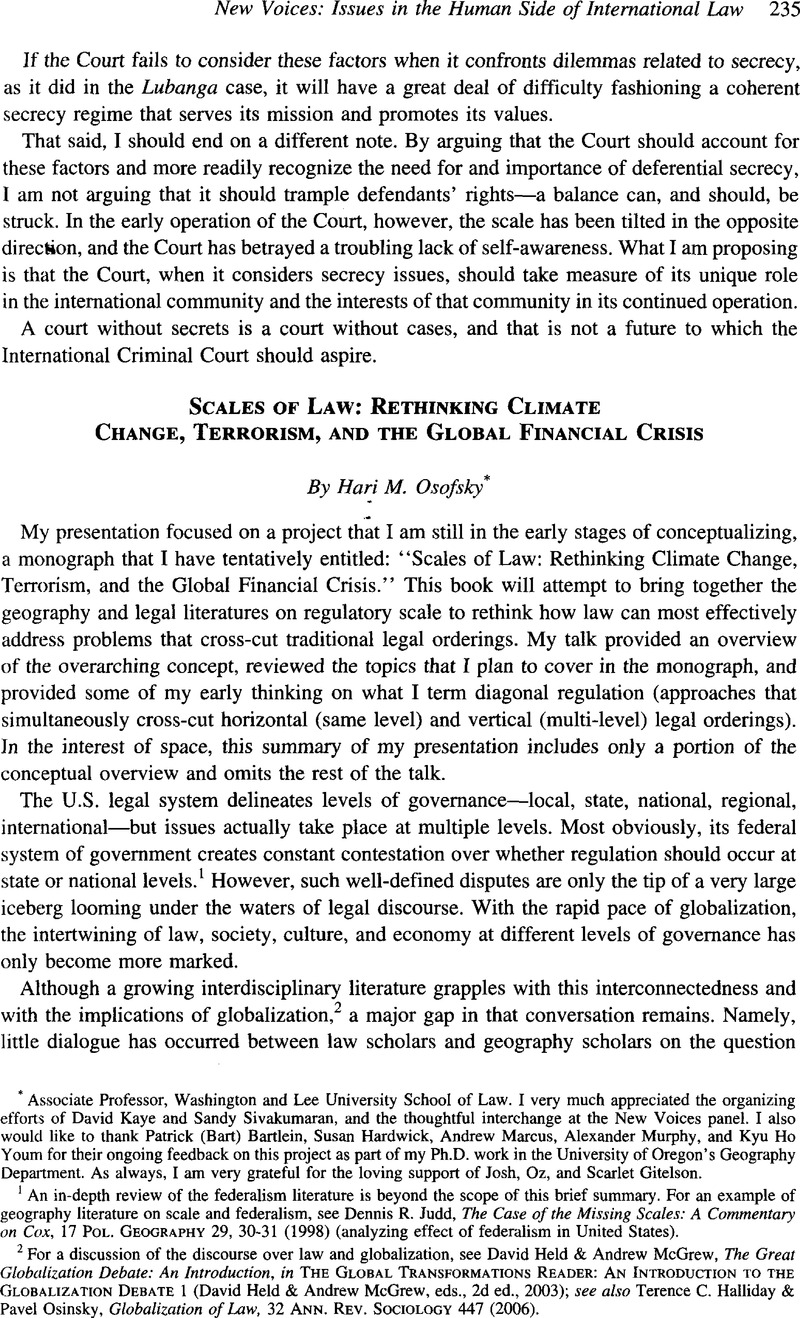No CrossRef data available.
Article contents
Scales of Law: Rethinking Climate Change, Terrorism, and the Global Financial Crisis
Published online by Cambridge University Press: 28 February 2017
Abstract

- Type
- New Voices: Issues in the Human Side of International Law
- Information
- Copyright
- Copyright © American Society of International Law 2009
References
1 An in-depth review of the federalism literature is beyond the scope of this brief summary. For an example of geography literature on scale and federalism, see Judd, Dennis R. The Case of the Missing Scales: A Commentary on Cox, 17 Pol. Geography 29, 30-31 (1998)Google Scholar (analyzing effect of federalism in United States).
2 For a discussion of the discourse over law and globalization, see Held, David & McGrew, Andrew, The Great Globalization Debate: An Introduction, in The Global Transformations Reader: An Introduction to the Globalization Debate 1 (Held, David & McGrew, Andrew, eds., 2d ed., 2003)Google Scholar; see also Halliday, Terence C. & Osinsky, Pavel, Globalization of Law, 32 Ann. Rev. Sociology 447 (2006)CrossRefGoogle Scholar.
3 For examples of those debates, see Marston, Sallie A. The Social Construction of Scale, 24 Progress in Human Geography 219 (2000)CrossRefGoogle Scholar, and dialogue over that piece in Brenner, Neil, The Limits to Scale? Methodological Reflections on Scalar Structuration, 25 Progress in Human Geography 591 (2001)CrossRefGoogle Scholar, and Marston, Sallie A. & Smith, Neil, States, Scales and Households: Limits to Scale Thinking? A Response to Brenner, 25 Progress in Human Geography 615 (2001)CrossRefGoogle Scholar. In addition, see Marston, Sallie A., Jones, John Paul III & Woodward, Keith, Human Geography Without Scale, 30 Transactions of the Institute of British Geographers 416 (2005)CrossRefGoogle Scholar, and responses to it, Hoefle, Scott William, Eliminating Scale and Killing the Goose that Laid the Golden Egg?, 31 Transactions of the Institute of British Geographers 238 (2006)CrossRefGoogle Scholar, and Collinge, Chris, Flat Ontology and the Deconstruction of Scale: A Response to Marston, Jones, and Woodward, 31 Transactions of the Institute of British Geographers 244 (2006)CrossRefGoogle Scholar.
4 For example , recent anthologies on law and geography do not have a major emphasis on scale. See Law and Geography (Jane Holder & Carolyn Harrison eds., 2003); The Legal Geographies Reader: Law, Power and Space (Blomley, Nicholas, Delaney, David & Ford, Richard T. eds., 2001)Google Scholar.
5 The legal pluralist literature, for example, engages the importance of addressing the multiple normative communities—formal and informal—that share social spaces. Cover, Robert M. The Supreme Court 1982 Term Foreword: Nomos and Narrative, 97 Harv. L. Rev. 4 (1983)CrossRefGoogle Scholar; see also Berman, Paul Schiff, Global Legal Pluralism, 80 S. Cal. L. Rev. 1155 (2007)Google Scholar; Merry, Sally Engle, Legal Pluralism, 22 Law & Soc’y Rev. 869 (1988)CrossRefGoogle Scholar; Melissaris, Emmanuel, The More the Merrier? A New Take on Legal Pluralism, 13 Soc. & L. Studies 57 (2004)CrossRefGoogle Scholar; Manji, Ambreena, “Like a Mask Dancing”: Law and Colonialism in Chinua Achebe’s Arrow of God, 27 J. Law & Soc’y 626 (2000)CrossRefGoogle Scholar; Tsuk, Dalia, The New Deal Origins of American Legal Pluralism, 29 Fla. St. U. L. Rev. 189 (2001)Google Scholar. Similarly, the New Haven School of International Law views law as “a process of authoritative decision by which members of a community clarify and secure their common interests” and argues that “humankind today lives in a whole hierarchy of interpenentrating communities, from the local to the global.” Harold D. Lasswell & Myres S. Mcdougal, Jurisprudence for A Free Society: Studies in Law, Science and Policy, at xxi (1992).
6 For discussion of issues of fixity and fluidity in the geography literature, see Cox, Kevin R. Spaces of Dependence, Spaces of Engagement and the Politics of Scale, Or: Looking for Local Politics, 17 Pol. Geography 1, 20-21 (1998)Google Scholar; Delaney, David & Leitner, Helga, The Political Construction of Scale, 16 Pol. Geography 93, 93 (1997)CrossRefGoogle Scholar; Herod, Andrew, Scale: The Local and the Global, in Key Concepts in Geography 229, 234 & 242 (Holloway, Sarah L., Rice, Stephen P. & Valentine, Gill, eds., 2003)Google Scholar; Martin, Deborah G. Transcending the Fixity ofJurisdictional Scale, 17 Pol. Geography 33, 35 (1998)Google Scholar; Paasi, Anssi, Place and Region: Looking through the Prism of Scale, 28 Progress in Human Geography 536, 542-43 (2004)CrossRefGoogle Scholar; Brenner, Neil, Between Fixity and Motion: Accumulation, Territorial Organization and the Historical Geography of Spatial Scales, 16 Envt. and Planning D: Soc’y and Space 459, 461 (1998)CrossRefGoogle Scholar; Swyngedouw, Erik, Excluding the Other: The Production of Scale and Scaled Politics, in Geographies of Economies 167, 169 (Lee, Roger & Wills, Jane, eds., 1997)Google Scholar; Swyngedouw, Erik, Neither Global nor Local: “Glocalization” and the Politics of Scale, in Spaces of Globalization: Reasserting the Power of the Local 137, 141 (Cox, Kevin R. ed., 1997)Google Scholar.
7 For analyses of issues of extent and resolution, see McMaster, Robert B. & Sheppard, Eric, Introduction: Scale and Geographic Inquiry, in Scale and Geographic Inquiry: Nature, Soc’y and Method 1, 5 (Sheppard, Eric & McMaster, Robert B., eds., 2003)Google Scholar; Sayre, Nathan F. Ecological and Geographical Scale: Parallels and Potential for Integration, 29 Progress in Human Geography 276, 281 (2005)CrossRefGoogle Scholar; Smith, Neil, Geography, Difference and the Politics of Scale, in Postmodernism and the Soc. Sciences 57, 73-74 (Doherty, Joe, Graham, Elspeth & Malek, Mo, eds., 1992)CrossRefGoogle Scholar.
8 For an example of an in-depth examination of those processes, see Neil Brenner, New State Spaces: Urban Governance and the Rescaling of Statehood 9 (2004).




